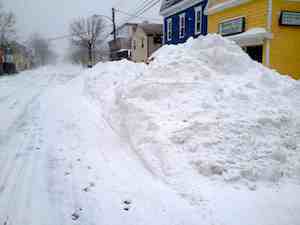13 Dec Our one-sided approach to snow danger
Nova Scotia school boards justify the 21st century epidemic of snow days on grounds of safety. It’s too dangerous, they argue, to put children in buses (even though buses are designed for safe transport and piloted by professional, specially licensed drivers). What if there’s an accident? What if even one child is injured? Since no one advocates dead or injured children, these emotional pleas tend to be argument stoppers.
The trouble with snow day logic is the fallacious assumption that school closures entail zero risk. A proper risk assessment would weigh the small risk of injury during transport to school — a process in which injuries are exceptionally rare — against the risks of setting 48,000 children (in the case of the Halifax Regional School Board) loose on short notice.*

The (Shelburne) Coast Guard used this photo of a year old storm to illustrate its preview of yesterday’s snowfall. Nova Scotia media often hype forthcoming weather with stock photos of events that happened long ago or elsewhere.
The failure to weigh both sides of the risk equation was glaringly obvious in yesterday’s decision by the Halifax board to send kids home at 11 am with barely an hour’s notice to parents.
Some families have a stay-at-home parent or caregiver. Some parents have employment flexible enough for them to scramble home in time to meet their kids. Some are lucky enough to make emergency backup plans on the fly. But in the name of safety, based on on the vanishingly small incremental risk of a 3 pm bus run over an 11 am bus run, the Halifax board sent hundreds, possibly thousands, of children home to empty or locked houses and apartments, with no apparent concern for the risks that created.
Also missing from the board’s calculation, as always, was the cost to parents and society of unnecessary or imprudent school closures. Either parents who rushed home due to the board’s recklessness will lose pay, or employers will absorb the lost productivity. Children get a subliminal message that it’s ok to abandon school and work when the going gets a wee bit tough.
Advocates of rampant snow days take umbrage at the suggestion financial and social costs can be weighed against even a tiny risk of injury to a child. But of course, parents and school officials take tiny risks every day of a child’s life. There are tiny risks involved in every ride to school, every gym class, every school outing, every recess.
No one in any school board has shown objective evidence that keeping schools open and buses running in normal winter weather poses greater risk than cancelling. They can’t show such evidence because it doesn’t exist.
—
* Another possibility is that such decisions are mandated by insurance policies, in which case only the insured risk is taken into consideration, while corresponding risks not covered by the policy are ignored.
